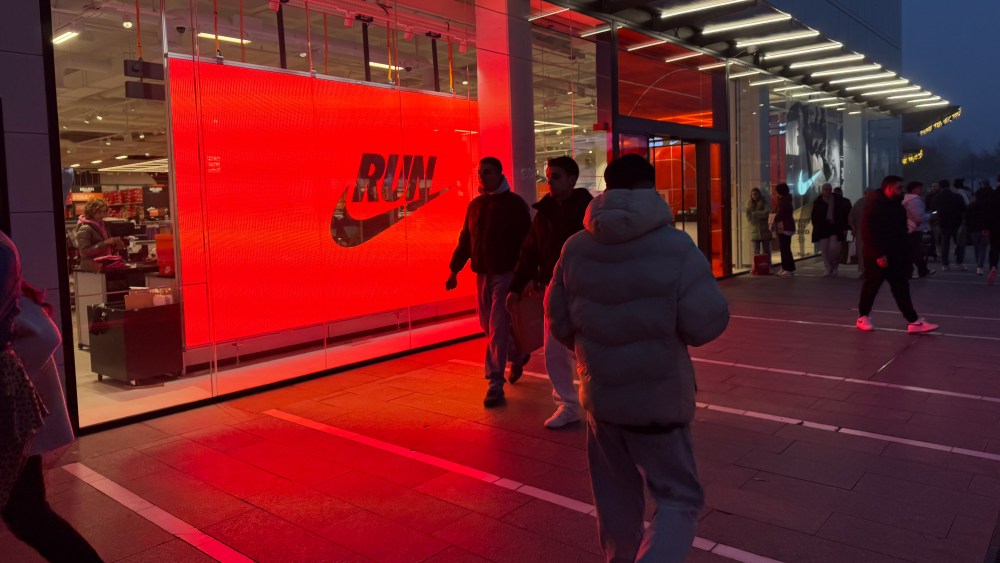Wall Street wants to know more about Dick’s Sporting Goods’ plan for , and where Nike fits in.
Telsey Advisory Group’s (TAG) Cristina Fernández said she’ll be looking for an update on Dick’s strategy for Foot Locker when the specialty outdoor retailer reports third quarter results on Tuesday.
Items on her agenda include: differentiation among Foot Locker product and that of Dick’s; plans for Foot Locker’s 2,300 stores; strategy for international, which represents 30 percent of Foot Locker’s sales and has underperformed the U.S.; investments needed to improve Foot Locker’s operations, such as stores, technology and marketing, and an update on Dick’s target to generate $100 million to $125 million in medium-term synergies and the targeted goal of having the acquisition be accretive to earnings per share (EPS) in 2026.
The TAG analyst has an “Outperform” rating — essentially the equivalent of a “Buy” rating — on shares of Dick’s and a 12-month price target of $255. Shares are trading in the $207 range. Current estimates of EPS is $2.72, but that’s only for the Dick’s operation because of the lack of information on Foot Locker’s contribution.
Dick’s completed its $2.4 billion Foot Locker transaction, first disclosed in May, on Sept. 8. The third quarter report should include about two months of Foot Locker results. Fernández said the expectation is that dick’s sales has “remained strong, driven by traffic to its stores, a differentiated merchandise assortment with a unique mix of national and private brands.” Also helping Dick’s standalone business is the successful opening of new concept stores, such as Dick’s House of Sport and Dick’s Field House, controlled promotional activity and operational execution.
Bank of America analyst Robert F. Ohmes projected third quarter EPS of$2.69, also on just the Dick’s business. He has a price target of $245.00. He has maintained his “Buy” rating on Dick’s stock, “given potential for improved vendor allocations and long term increasing profit contribution from Foot Locker.”
The big question following the acquisition is the expected strengthening of brand partnerships, with Nike at the top of the list.
“We see sizeable opportunity for combined Nike penetration — at about 38 percent combined in 2024 — to return to pre-2019 levels,” Ohmes said. The analyst said “we also see potential for Foot Locker to benefit from Dick’s staging and presentation of brands, higher margin clearance capabilities, private label and digital.” And he said Dick’s could strengthen relationships with brands through its global presence with Foot Locker and an expansion of open-to-buy.
Ohmes said the footwear category has been up “double-digit percent” in each of the last four years, and “should continue to grow in Fiscal 2026 as Dick’s has room to expand depth/breadth of footwear assortment, including with [the brands] Hoka and On.” He said Dick’s and Foot Locker’s combined penetration of footwear could rise to 50 percent, versus just Dick’s at 28 percent in 2024.
A bull-case scenario following the Foot Locker acquisition has Dick’s doubling its total addressable market to $300 billion globally from $140 billion in the U.S., with a distribution capacity that include 3,200 stores in 20 countries and licenses stores.
Ohmes also noted three possible bear-case scenarios. The first is that Dick’s comparable store sales have outperformed Foot Locker comps for the last 12 quarters, so that there’s a possibility that Dick’s could have acquired one of the retailers it has been gaining market share from. A second is that Nike penetration at Dick’s already rose in 2024 and there could be a risk of brands expanding to other retailers if Nike is allocated more selling space, Ohmes said. And the final potential cause for concern is that the U.S. population between ages 15 and 24, the range Ohmes said represents the core buying demographic for athletic apparel and footwear, is set to decline starting in 2025 through 2040.
It was learned on Monday that Foot Locker scrapped its plans to move its headquarter to St. Petersburg, Fla. The deal to relocate its global headquarters was part of the plan of its former management, including ex-CEO Mary Dillon, before the athletic footwear retailer inked its agreement to be acquired by Dick’s.
Separately, Jefferies analyst Randal J. Konik recently met with Nike’s management. His assessment following that meeting is that “Nike’s brand remains strong for the long term, supported by product innovation and emotional storytelling.”
Konik said that Nike’s management emphasized that progress is ongoing, and that it is focused on product innovation, leading with sport and rebalancing distribution. More importantly, “[m]essaging remained consistent. The company continues to execute its strategy, aiming for long-term brand strength while navigating near-term challenges.”
The Jefferies analyst noted that the Nike team in North America has reset over 1,300 running spaces at key retailers, which has enhanced brand visibility and consumer access. He noted that there are pockets of strength in “retro running footwear,” and that Nike’s actions are helping to build a “healthier brand presence with consumers.
In Europe, Nike continues to build momentum in running and global football, but the region remains more promotional due to increased discounting to manage inventory and align it with partners. And in Greater China, recovery is expected to take longer due to marketplace dynamics. There are over 5,000 mono-brand stores in China, and the lack of outlet or off-price liquidation levers means inventory management take more time.
